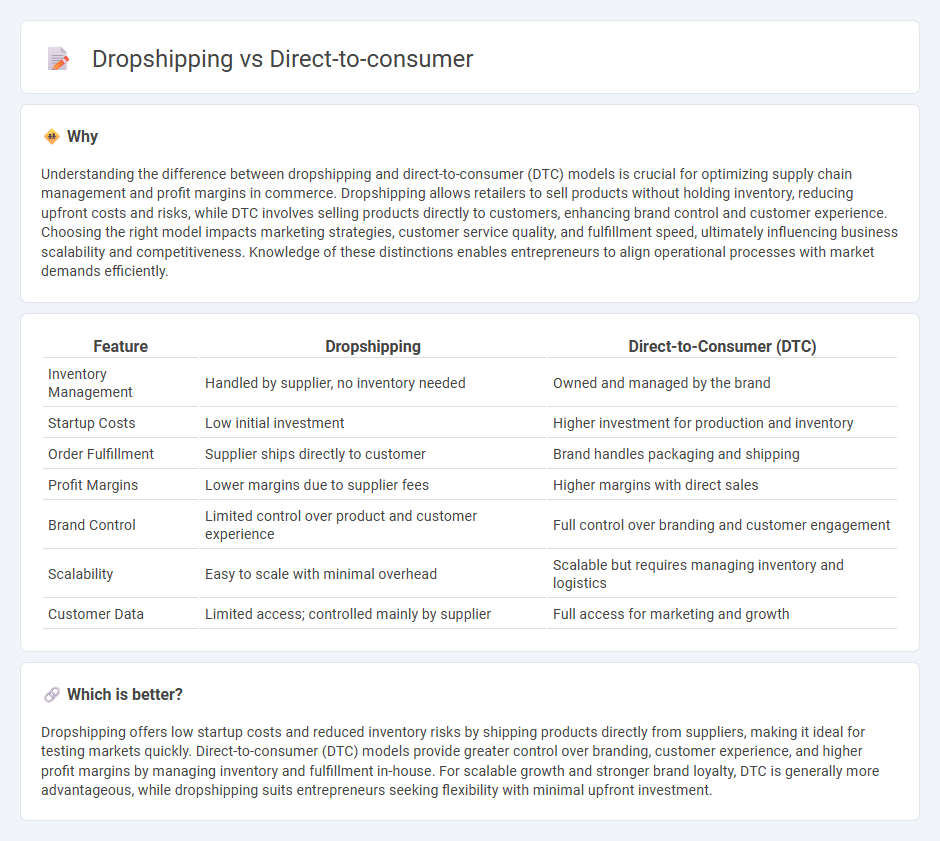
Dropshipping enables retailers to sell products without holding inventory, relying on suppliers to handle fulfillment and shipping directly to customers. Direct-to-consumer (DTC) brands manage production and distribution themselves, fostering closer customer relationships and greater control over product quality and branding. Explore the key differences between dropshipping and DTC to choose the best e-commerce strategy for your business.
Why it is important
Understanding the difference between dropshipping and direct-to-consumer (DTC) models is crucial for optimizing supply chain management and profit margins in commerce. Dropshipping allows retailers to sell products without holding inventory, reducing upfront costs and risks, while DTC involves selling products directly to customers, enhancing brand control and customer experience. Choosing the right model impacts marketing strategies, customer service quality, and fulfillment speed, ultimately influencing business scalability and competitiveness. Knowledge of these distinctions enables entrepreneurs to align operational processes with market demands efficiently.
Comparison Table
| Feature | Dropshipping | Direct-to-Consumer (DTC) |
|---|---|---|
| Inventory Management | Handled by supplier, no inventory needed | Owned and managed by the brand |
| Startup Costs | Low initial investment | Higher investment for production and inventory |
| Order Fulfillment | Supplier ships directly to customer | Brand handles packaging and shipping |
| Profit Margins | Lower margins due to supplier fees | Higher margins with direct sales |
| Brand Control | Limited control over product and customer experience | Full control over branding and customer engagement |
| Scalability | Easy to scale with minimal overhead | Scalable but requires managing inventory and logistics |
| Customer Data | Limited access; controlled mainly by supplier | Full access for marketing and growth |
Which is better?
Dropshipping offers low startup costs and reduced inventory risks by shipping products directly from suppliers, making it ideal for testing markets quickly. Direct-to-consumer (DTC) models provide greater control over branding, customer experience, and higher profit margins by managing inventory and fulfillment in-house. For scalable growth and stronger brand loyalty, DTC is generally more advantageous, while dropshipping suits entrepreneurs seeking flexibility with minimal upfront investment.
Connection
Dropshipping enables direct-to-consumer (DTC) brands to sell products without holding inventory, streamlining order fulfillment through third-party suppliers. This connection reduces overhead costs and allows DTC companies to focus on marketing and customer engagement. Efficient supply chain management in dropshipping supports the scalability and customization essential to successful DTC commerce models.
Key Terms
Inventory Management
Direct-to-consumer businesses maintain and control their own inventory, allowing for precise stock management and faster order fulfillment, reducing the risk of stockouts and overstock issues. Dropshipping relies on third-party suppliers to handle inventory, which minimizes upfront costs but can lead to challenges in inventory accuracy and longer shipping times. Explore detailed strategies to optimize inventory management in both models for improved operational efficiency.
Brand Ownership
Direct-to-consumer (DTC) business models enable full brand ownership, allowing companies to control customer experience, pricing, and product quality directly. Dropshipping, however, limits brand control as products are sourced from third-party suppliers, creating potential inconsistencies in inventory and fulfillment. Discover how brand ownership impacts your e-commerce strategy by exploring the advantages of each model in detail.
Fulfillment Process
Direct-to-consumer (DTC) fulfillment involves managing inventory, packaging, and shipping directly from the brand to the customer, ensuring greater control and faster delivery times. Dropshipping fulfillment relies on third-party suppliers to hold inventory and ship products on behalf of the retailer, reducing upfront costs but potentially increasing shipping times and variability in product quality. Explore detailed strategies and best practices to optimize fulfillment efficiency in both models.
Source and External Links
Direct-to-consumer - Wikipedia - Direct-to-consumer (DTC) is a business model where brands sell products directly to customers, bypassing any third-party retailers or middlemen, often via online platforms but sometimes including physical stores as well.
What Is Direct-to-Consumer? Everything You Need To Know (2024) - Direct-to-consumer sells products directly to customers through brand-owned ecommerce sites or digital channels, allowing brands to control fulfillment, marketing, and customer relationships without middlemen.
Direct to Consumer (D2C) Guide | Salesforce US - DTC involves brands selling their products straight to end users via channels like ecommerce websites, social commerce, and apps, offering an alternative or complement to traditional retail partners.
 dowidth.com
dowidth.com